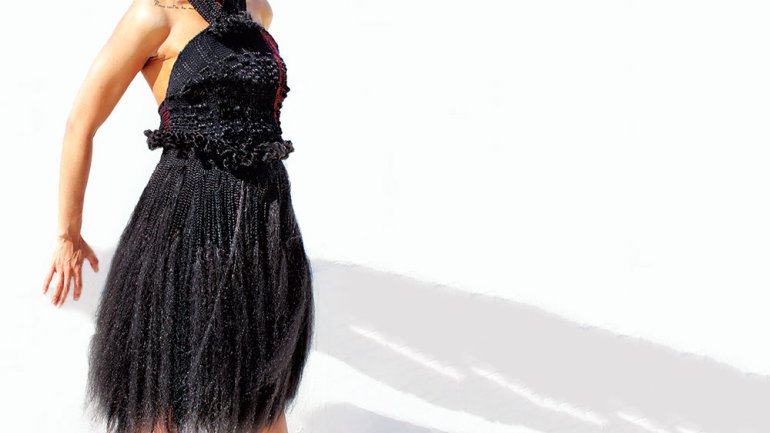Ties that Bind
Ties that Bind
Growing up, Shenequa A. Brooks and her younger sister were like many siblings – frequently at odds. “We never saw eye to eye,” says Brooks, 22. “But when she would do my hair, we were at peace. We would hear one another, and we would laugh.”
For Brooks, hair came to symbolize family and love. No wonder, then, that ever since she’s been making art, her go-to material has been hair – synthetic locks that she braids, twists, weaves on a floor loom, and combines with beads, yarn, and other elements to make richly textured wall sculptures.
In 2014, her senior year at the Kansas City Art Institute, she made hair the theme of her thesis show, “Synthetic Ties,” and hung her pieces on the walls of a local beauty salon. Throughout the day, stylists and customers would go about their business, bringing to life her concept of sisterhood centered on hair.
“When you go to a salon, it’s about more than just your hair,” she says. “You’re relaxed; it’s a gossip time with your girls, time to vent. You talk about life. Sometimes it’s a mini-therapy session.”
Community is a subject that has always interested Brooks in a personal way. Born in St. Thomas, US Virgin Islands, she moved to Miami with her mother and sister when she was a small child. She grew up there surrounded by family and friends from the Caribbean and spent summers with her father in the islands. As a teen, she attended the New World School of the Arts, where her early artmaking celebrated her heritage – the tropical colors, the reggae and soca music, the joyous pageantry of Carnival. Fashion was another big influence. Watching TV shows such as Project Runway, she’d deconstruct the garments in her mind. As a freshman in college, she made a dress out of papier mâché and construction paper.
She also developed a fascination with Ghana, in particular its iconic kete cloth (also known as kente cloth), made of woven strips of cotton and silk in dazzling colors and geometric patterns. Each color and pattern has a meaning; when woven together, the cloth creates a new meaning. Last year, just before KCAI graduation, she won a Windgate Fellowship from the Center for Craft, Creativity & Design to travel to Ghana and learn to weave kete herself. “All these textiles I had seen in pictures – now I wanted to make them.”
She spent three months in Anloga, a farming village, studying with master weaver Sebastian Dayi. Most kete weavers are men, and Brooks was the first woman he had ever taught. “When we met, he had his doubts,” she recalls. “He looked at me and said, ‘Are you sure you want to do this?’ He was thinking, ‘You’re in way over your head here. But OK, if you want to, let’s go.’ ”
Under Dayi’s tutelage, she wove outdoors in the balmy weather, all day, every day. The work made her deeply happy, though it was demanding: “I had to strive not to disappoint myself – or him.” There was occasional tension between the exacting master and his young student, who had to put aside artistic expression to learn the craft in the traditional way. “At the end of the day, he was extremely proud of me,” she says.
Brooks left Ghana reluctantly, returning to the US a transformed person. “I walked away with love, [a sense of] what family really means, what community really means.” She brought back a traditional kete loom that village woodworkers had built for her, which she’s been using as she explores hair as a material. “I thought I was done with that conversation, but I’m not.”
This fall she starts at the School of the Art Institute of Chicago, pursuing a master’s of design in fashion, body, and garment. Her Ghana sojourn is still in her heart and mind, inspiring her to think differently about identity, gender, race, culture. “I’m trying to figure out a way to articulate all of it in my art. It’s going somewhere. I just don’t know which direction yet.”

